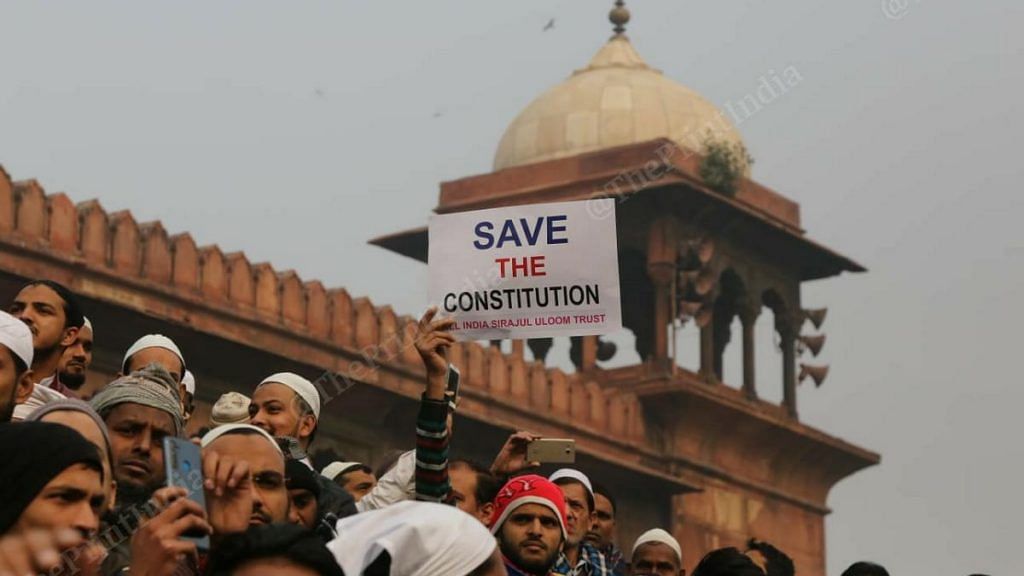Ever since the protests against the Narendra Modi government’s decision to amend the Citizenship Act and plans for a nationwide NRC started, the Indian Constitution has been at the centre of it. The document has become a talisman for protesters.
Bhim Army chief Chandrashekhar Azad held it up among a sea of protesters in the Jama Masjid, students and citizens read it out together in front of the India Gate, and Asaduddin Owaisi read the preamble loud and clear to thousands in Hyderabad. The Constitution is seeing a kind of rebirth — from the lodestar of Indian democracy to an active tool in the fight for its survival.
“We, the people of India, having solemnly resolved to constitute India into a SOVEREIGN SOCIALIST SECULAR DEMOCRATIC REPUBLIC…”
United against the CAA, which promises citizenship to non-Muslim refugees of six communities from Pakistan, Afghanistan and Bangladesh, the average Indian citizen has found her voice in these words.
This is why the Indian Constitution is ThePrint’s Newsmaker of the Week.
Also read: India’s new Muslim flaunts Tricolour, sings national anthem & isn’t afraid to look Muslim
From textbooks to the streets
With its 448 articles, 12 schedules, 5 appendices and more than 100 amendments, the Constitution of India is the longest written constitution in the world. The Constitution of the US, a country which is referred to as the oldest democracy in the world, only has 4,400 words as opposed to 1,45,000 words of the Indian Constitution.
The Constituent Assembly drafted the Constitution over a period of almost three years. It comprised several eminent Indian leaders including B.R. Ambedkar, Jawaharlal Nehru, Vijaya Lakshmi Pandit, Sarojini Naidu and Vallabhbhai Patel. Indian Constitution expert Granville Austin, wrote in his 1966 book The Indian Constitution: Cornerstone of a Nation, that the document “expresses the will of many rather than the needs of the few”.
But the Indian Constitution is more than just the country’s governing document. The Constitution is transformative because it has redefined the relationship between the people and those who govern them. It is also revolutionary because it attempts to lay down a framework for coexistence of liberal constitutionalism and religious pluralism.
However, the Constitution’s understanding has often been considered a prerogative of the privileged few; its study limited to law school curriculum, and its selective portions adorning CBSE curriculum textbooks.
And that is why images of thousands of protesters across the country reciting the Constitution to drive their point home is so significant. The Constitution declares that it derives its power from the people themselves, and with these demonstrations, the citizens are reclaiming this power.
Also read: Why India is home to millions of refugees but doesn’t have a policy for them
States vs people
However, it is not just the protesters who are finding solace in the words of our Constitution.
PM Narendra Modi also drew from the Indian Constitution, without making a direct reference to it, to remind those who damaged public property that they must “not forget that rights and duties go hand in hand”. But when he uttered these words while unveiling a statue of former Prime Minister Atal Bihari Vajpayee in Lucknow Wednesday, his focus was not on what the preamble guarantees or the fundamental rights enshrined in the Constitution. His focus was solely on the ‘duties’ aspect and not the ‘rights’.
And this isn’t an isolated incident. PM Modi has made selective references to the fundamental duties ever since his 2019 Lok Sabha election victory. Soon after the win, Modi called for a “paradigm shift” in India — from the centrality of fundamental rights to the fundamental duties.
In the past few months since June, the Modi government has made concerted efforts to drive this paradigm shift. So much so, that for the celebrations of the 70th anniversary of the Indian Constitution last month, students of higher education institutions were asked to take a “pledge” to abide by the fundamental duties.
The part on fundamental duties was added in the Constitution, as expert Vineeth Krishna points out, by Indira Gandhi during the Emergency in 1976.
Also read: If Modi-Shah succeed in CAA-NRC project, these consequences will alter Indian society
The supreme power of Constitution
The Modi government and those protesting against the CAA-NRC are citing different portions of the Constitution to make their case against each other.
While people want the state to focus on fundamental rights, PM Modi’s drive to focus on fundamental duties displays an attempt to shift the onus and accountability on people rather than the state.
The petitions challenging the constitutional validity of the CAA are still pending before the Supreme Court, but it has asked the Modi government to submit its response to the matter by the second week of January 2020.
However, with people in the country taking to the streets with a copy of the Constitution, they are finally exercising their rights to make their elected representatives aware of their objections and opinions. They are reiterating the fact that it is the Constitution that is supreme. And the Constitution ensures that the supremacy of the people is upheld.
Also read: Modi wrongly quoted Mahatma Gandhi on Pakistan’s Hindu & Sikh refugees to defend CAA
